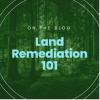By: LBX Editorial Team
SOURCE: Land Betterment Corporation
DESCRIPTION:
SYNOPSIS:
Similar to Crypto 101, this is an informative overview of what Land Remediation is. Can treat like a listicle if that’s easy. Want to cover the big terms, who are doing the polluting, current challenges, stats, etc. Couch this in why LBX has a solution to the problem and how people can get involved.
Contaminated land is nothing new to this world. Some of that poisoned land is more memorable than others, such as Chernobyl and the Three Mile Island Accident. These nightmares prove that environmental pollution ruins a society.
On a lesser reported scale, impacted land from coal mining and other hazardous activities is a relentless slayer around the world, and often accepted as a part of powering a modern society. But the world is suffering.
In this blog, we’ll do a small dive into what land remediation is, the challenges we face, the LBX solution and some notable land remediation efforts throughout the last 50 years.
What is Land Remediation?
There are a variety of land remediation efforts dedicated to restoring and developing scarred land, mostly involving the removal of contaminants from soil and water. Remediation eliminates contaminants from polluted sites from mining, manufacturing, industrial and commercial processes.
Remediation includes an end-to-end process starting with :
- Detection
- Inspection
- Assessment
- Determination of remedial measures
- Clean up
- Redeveloping the site
Scarred land sites range from residential areas—like houses and apartment buildings containing serious asbestos exposure—to quarries or mines, or industrial sites like factories that throw hazardous waste nearby or weren’t properly cleaned up when work was completed. With thorough site assessment and meticulous project management, experts develop environmental management plans that remediate these locations for either commercial ventures or non-threatening green areas.
Why Remediate?
Scarred land directly affects a community’s health and well-being. Long-term, adverse health effects can cause cancer. Children can’t even play outside without risking nosebleeds due to radiation and polluted air. The side effects are all measured as incremental health risks.
Once these incremental health risks are removed, communities can reclaim what was lost. Parks, schools and town squares can replace the toxic soils that were enveloping the area. Instead of being swallowed by history’s mistakes, we can clean up with land remediation and look forward to healthier activities.
On a lighter note, removing a blot on the environment is good economic use on wasteland. The same location where a child got a nosebleed can turn into a schoolyard or park—sans nosebleeds.
Regulation Standards
Land remediation is a cumbersome task that demands expert knowledge and skills to achieve recovery. To ensure recovery, efficient project management is a prerequisite, along with a comprehension of engineering, physical sciences and chemistry.
Environmental project management is also a principal phase in demolition projects. The management team has to examine the ecological condition and remove contamination at a site before dismantling it. If not, the demolition process could cause hazardous toxic waste emissions that would greatly impact workers and residents in the area.
Remedial action follows regulatory requirements based on human health and ecological risks where standards are advisory.
Advised standards consider levels of noise, odor, dust, groundwater and air emissions, as well as sewers and waterways discharging chemicals by the processing of the contaminants. Once companies observe the land and implement a step-by-step process to recover the land, remediation can commence.
Notable Remediation Projects
Hunters Point Shipyard
Located in San Francisco, Hunters Point has been inundated with polluting facilities in this neighborhood that spans four square miles. Sequestered between the San Francisco port and two traffic-ridden freeways, 86% of children in this community developed severe asthma before kindergarten.
Bayview has been publicly identified by California as, “Disproportionately burdened by multiple sources of pollution,” and the community has been promised help for many years, which has not been seen.
Being a shipyard area, the Navy is responsible for cleaning up the land. If and when the Navy remediates Hunters Point, the land will be transferred for redevelopment as parks, homes and commercial spaces.
Homebush Bay, New South Wales Australia
Controlled and uncontrolled waste dumping transformed Homebush Bay from the once exuberant wetlands into polluted waterways. Nestled next to Sydney, Homebush Bay’s remediation started in 1992. During the production of a now-banned pesticide and foreign agent, Union Carbide dioxins orange polluted the Australian landscape.
After years of rigorous work, Homebush Bay remediation was completed in 2010, but a fishing ban will continue for decades. While water activities aren’t available, the area is now a park
Looking Forward
We are still in the early stages of new land remediation efforts and strategies around the world, and here at home. Over the years, communities have become familiar with broken promises that their children will soon live in a clean environment. But with the right incentives in place, corporations can effectively recover land that is owed to discouraged communities.
To enhance the practicality of land remediation, companies like the LBX are using cryptocurrency to incentivize industry and other partners to clean up sites. As the world sees positive steps forward in the remediation of industry-impacted land, communities will finally enjoy a wealth of bountiful landscapes well into the future.
About Land Betterment Exchange (LBX)
Land Betterment Exchange (LBX) is an environmentally driven token that creates a financial incentive and trading market to pull forward environmental cleanup and expedite the transition away from fossil fuels while providing new sustainable livable wage jobs for the local community. It is a token built off the ERC-20 Ethereum framework that provides a direct financial incentive to promote and accelerate environmental cleanup of negatively impacted lands from the fossil fuel industry. Land Betterment Exchange has engaged Land Betterment as its token issuance partner to ensure that the integrity of the token issuance process is adhered to and the environment cleanup is completed. Land Betterment Exchange (LBX) is in the final stages of selecting a cryptocurrency exchange for its initial token listing. Visit the Company at lbxtoken.com and track us on your favorite platform for more information on our imminent listing and the environmental value of the LBX token. Facebook, LinkedIn, Instagram, Reddit, Tiktok.
About Land Betterment Corporation
Land Betterment Corporation, an Indiana Benefit Corporation and Pending B-Corp, is an environmental solutions company focused on fostering a positive impact through upcycling former coal mining sites to create sustainable community development and job creation. The Company utilizes a complete solution-based lifecycle program to restore and rehabilitate the environment and revitalize communities in need of change and opportunity. Land Betterment accomplishes this by identifying un-reclaimed, run-down and neglected coal mining sites, fixing the environment through reclamation and remediation, and then repurposing the land to support a sustainable business that serves the community. Land Betterment firmly believes that with real solutions it is possible for restoration of impacted areas to live side-by-side long term employment, while building sustainable and safe surroundings for communities and our planet. Visit the Company at landbetterment.com and connect with us on LinkedIn Twitter and Facebook.
Company Contacts:
Mark LaVerghetta
317.537.0492 ext. 0
Chief Governance Officer, Corporate Finance
info@landbetterment.com
Stephanie Conzelman
207.205.0790
Stakeholder Engagement Director
info@landbetterment.com
KEYWORDS: Land Betterment








